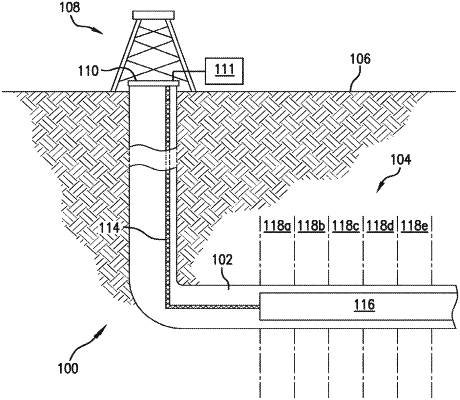| CPC E21B 47/10 (2013.01) [E21B 33/13 (2013.01); E21B 43/26 (2013.01); E21B 47/06 (2013.01); E21B 47/07 (2020.05); E21B 47/09 (2013.01); E21B 49/00 (2013.01); E21B 49/006 (2013.01)] | 18 Claims |

|
1. A method of controlling well bashing during stimulation treatment, comprising:
applying a treatment to at least a first well of a plurality of wells in a subterranean formation;
collecting a first-well measurement from the first well and a second-well measurement from a second well penetrating the subterranean formation, wherein at least the second well includes a fiber-optic sensor configured for distributed sensing along the second well;
determining a flow distribution across a plurality of formation entry points along a portion of the first well using at least one of the first-well measurement or the second-well measurement, wherein the first-well measurement is taken at the first well, and wherein the second-well measurement is taken at a plurality of locations along the second well and comprises measurements from the fiber-optic sensor;
determining a fracture volume of injection fluid entering the plurality of formation entry points using the determined flow distribution across the plurality of formation entry points; determining a fracture length between the first well and the second well based on a relationship of the fracture volume with the fracture length, Young's modulus, a fracture height, a stress intensity factor, and Poisson's ratio, wherein the relationship is described by an equation:
 wherein Vfp denotes the fracture volume, E denotes Young's modulus, h denotes the fracture height, KIC denotes the stress intensity factor, v denotes Poisson's ratio, and Lf denotes the fracture length;
determining if the applied treatment at the first well interferes with the second well, using the determined length of the fracture; and
making real-time adjustments to a baseline treatment schedule responsive to the determined flow distribution to control a diverter deployment over the course of a treatment stage of the stimulation treatment, wherein the diverter deployment comprises applying a diverting material at the first well if it is determined that the applied treatment interferes with the second well, in order to control well bashing of the second well.
|